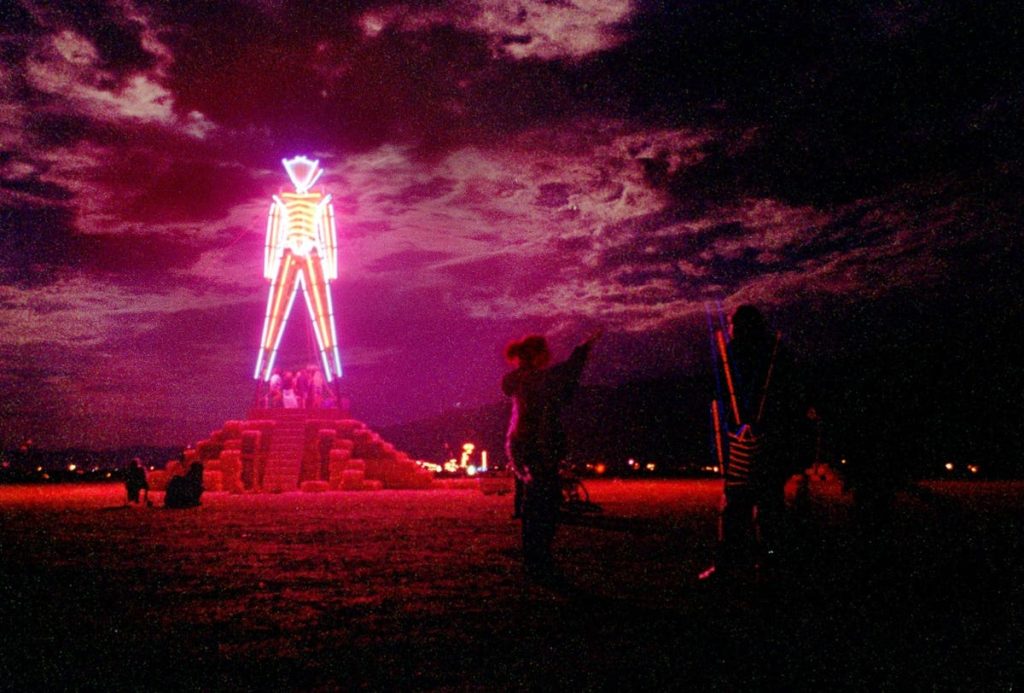The Burning Man (BM) is an iconic music festival held every year in Nevada (although it started in San Francisco in 1986). It is in the news because of the unprecedented rain and flood that has stranded over 70,000 attendees at the campsite, Black Rock City. Although BM began as a counterculture event, it now also attracts the affluent high-tech crowd, some of whom arrive in private planes and luxury RVs. This gentrification has provoked climate activists from the Seven Circles Alliance, which includes groups such as the Extinction Rebellion, Rave Revolution, and Scientists Rebellion, to block the road leading to the Black Rock City. They were protesting against what they see as both systemic issues and individual choices that are driving the climate crisis. Their grievances target capitalism in general and the Burners’ high carbon footprints and techno-optimism. Emily Collins, from the Rave Revolution, stated “There are a lot of people thinking, oh, I’m a vegan, I drive an electric car, I’m working in sustainability….It’s a very technocratic, privileged mindset.”
Arguably, the counterculture Burner crowd (which includes two billionaires who want to participate in a cage fight) should not have problems with counterculture protests. But it worked out differently. The Burners booed the activists blocking the road to the campsite. Moreover, the protesters were not welcomed by the Tribal Nation that owns this land. They were detained by the Pyramid Lake Paiute Tribal Police which smashed through the activists’ road barriers. This raises the obvious question: Why are the “natural allies” of the climate movement not supporting their protests?
Broadly, disruptive climate protests have taken place across countries and in many forms. These include the recent protests at the annual Jackson Hole Economic Symposium, the annual gathering of top economists, central bankers, and policymakers. Earlier in the summer, activists protested outside the East Hampton Town Authority, where many New York billionaires park their private planes. Protesters have also targeted fossil fuel pipelines, coal terminals, and major highways.
Why museum vandalism?
In 2022, these protests took a novel form: museum vandalism. But why target museums? It is true that museums are typically frequented by privileged sections of society. Yet, a large number of people visit museums and find inspiration in the great works of art. Because museums reflect important artistic and aesthetic achievements of humankind, it is difficult to claim that they epitomize capitalism, techno-optimism, or high carbon footprints. Thus, unlike BM protests which also target individual choices, vandalizing museums is aimed at system-level changes.
In a recent paper with Lily Kinyon (paper and dataset are available here), we examined where and when museum protests take place and which groups are involved. We counted thirty-eight incidents of museum vandalism in 2022. We find that these took place in eleven countries, nine of which are in Europe. Even within Europe, 60% of the incidents occurred in just three countries: Germany, Italy, and the UK.
This Europe-specific protest strategy involved a handful of groups. Three groups account for 58% of these incidents: Ultima Generazione (Italy and Vatican), Just Stop Oil (UK), and Letzte Generation (Germany). Moreover, traditional environmental groups such as Greenpeace, that have historically employed radical activism seem to be absent from such protests. This brings up the question of a generation divide among climate activists.
The timing of these incidents is also interesting. We find that almost all thirty-eight reported incidents occurred during May-December 2022, with protests peaking around the COP 27 conference in Sharm El Sheik, November 6-18. Clearly, museum vandalism was a carefully planned activity, not a spontaneous outburst. Indeed, activists filmed their protests, whether throwing tomato soup on a painting or gluing themselves to it, and posted them on social media. Thus, as opposed to mass protests involving a large number of people (as in Greta Thunberg’s Fridays for Future strikes), typically a very small number of activists staged a dramatic event and used social media to amplify their message. This makes us wonder whether this is a mass movement or a social media-based elite movement.
Did this tactic succeed? If it did, then perhaps activists could be expected to expand its scope and frequency. However, the opposite has happened. Museum vandalism has almost stopped in 2023, with only three incidents to date: Degas’ “Little Dancer” in Washington DC, Rome’s Trevi Fountain, and the Monet Painting at Sweden’s National Museum.
Do such tactics bring about policy change?
Disruptive protests are aimed at increasing support for climate action among the public and policy makers. To assess their success, we need to explore the theory of policy change. The implicit theory seems to be that a lethargic climate action is due to the lack of awareness about the climate problem. But what if the dominant reasons are the political and institutional bottlenecks, and the unwillingness of the general public to switch to a low carbon lifestyle?
Opinion polls suggest that across the world, people recognize the anthropogenic aspect of climate issues. But might these incidents increase policy salience and motivate policymakers (or business bros, as in Burning Man) to prioritize climate action over other concerns? Or, might disruptive tactics create a “radical flank” effect that incentivizes policymakers to negotiate with the “mainstream” climate movement?
On the contrary, these protests might be undermining support for climate issues. A recent report finds that the French government has ordered the dissolution of the climate group Les Soulèvements de la Terre while the British government has passed a law against individuals attaching themselves to objects (such as museum paintings) or buildings (such as the parliament). In Italy, the government wants to impose hefty fines on activities vandalizing cultural landmarks. Both Belgium and the Netherlands are imposing criminal penalties on activists.
What about public reaction?
When activists disrupt highways or railways and cause public inconvenience, ordinary people tend to get frustrated. In some instances, climate protesters have been roughly evicted by the public. Even museum protests draw anger because visitors probably invested time and resources in planning their visits. Acts of vandalism might shut down museums or specific exhibits and frustrate museum visitors.
What then is the step forward? Climate issues do not seem to generate support when they impose long-term costs involved in policy changes. This is why U.S. environmentalists do not typically talk about a federal carbon tax. Protests in France, the UK, and the Netherlands reveal that the public reacts negatively to long-term costs. But the public opposes disruptive action even when it imposes one-time costs from disrupting everyday commutes, holidays, or cultural events.
This is not to say that protests never succeed. Our sense is that disruptive tactics that target a specific project (such as the expansion of an oil pipeline or drilling permit in a wildlife refuge) and have few spillover costs on the general public have a greater chance of success. Disrupting BM or vandalizing museums do not have these characteristics. This is why they have had a modest impact on the policy process.
Read the full article here









